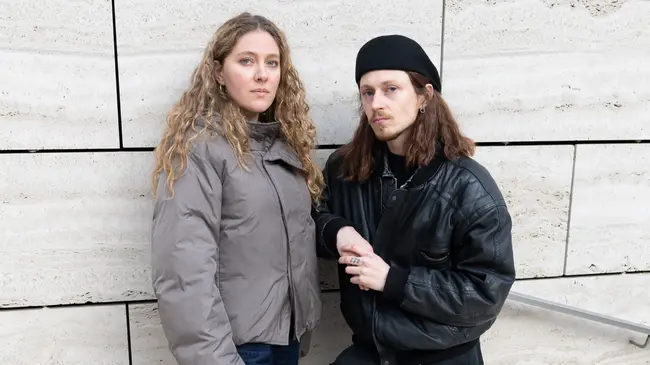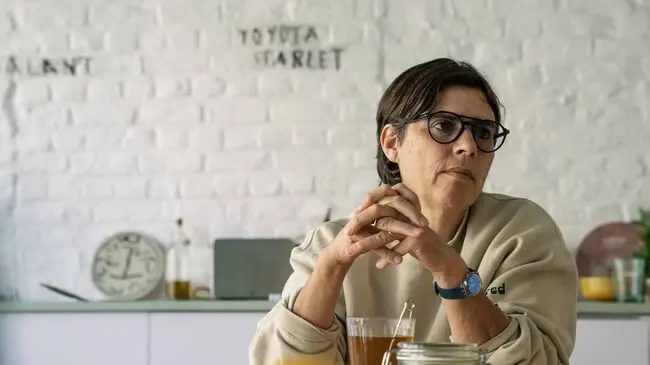It took time to embrace my love for things that are purely aesthetic

Currently on view in the Brussels Fashion and Lace Museum is Belgium’s first-ever exhibition entirely dedicated to men’s fashion. Armed with a booklet full of info, a pliable LED-light and the by now inevitable mouth mask, we visited the expo titled Masculinities with Ghent-based photographer Jonas Van der Haegen. A recent KASK graduate, Jonas’s work often has the queer male\* body as its main focus. Quite the fashion-savvy artist himself - he even studied fashion at the Academy in Antwerp for a year before turning to the camera instead - we asked Jonas which parallels he sees between the art of fashion and his own work.
What role does fashion play in your life? Do you use clothing to express yourself?
Yes, I do use fashion to express myself, but I also admire the art of fashion: the feeling for aesthetics, the craftsmanship, the attention to detail… I truly believe fashion is the highest form of art and design. You create something which people are going to wear, it’s art that’s intended to be used. People take your work and adjust it to their liking and create a world on their own body, maybe even with one piece of yours, they give it a life beyond whatever concept or intention you had when you designed it.
I truly believe fashion is the highest form of art and design
Fashion - for me personally - is an easy way to express things. If you look at how music and atmosphere come together in a fashion show and look closely at the models that are cast, the way they are asked to walk: all these details tell you so much about a collection, a designer, a house… There’s a whole world being created with all those elements.
After graduating from high school, I studied fashion for one year, but it was too much for me, especially the technical side of things. I was seventeen and had never sewn before, it was horrible how bad I was at executing my ideas. I was used to drawing and making collages, which are quick and rather impulsive ways of expressing my imagination. But at the Academy there were weeks of painstakingly hard work between the idea and the product, and I quit after one year. But I still really love fashion, although I express it more in styling nowadays than in making garments from scratch.


You describe how fashion designers are able to design atmospheres by paying attention to every detail. How does this translate to your work as a photographer?
In photography as well as in fashion you can play with a lot of different options. When it comes to presenting my work, I ask myself questions like ‘Am I going to frame my work? Am I going to glue pictures on the wall or am I going to use nails?’ And then you can choose how far you want to go with these details. If you choose to frame an image, what kind of wood are you going to use, and should the paper be glossy, matte, textured maybe? All these choices, combined with the work itself, are crucial in translating a photograph from a 2D-image to an experience for your spectators.
When I had an exhibition in Japan, for example, I printed my work on posters and glued them to the wall. The glue gives a very specific texture and creates air pockets which brings the images to life. The result had a very ‘street’ feel to it and nodded to advertising, which is present everywhere in Tokyo and translates to the subject (Japan) again. Putting up posters is a very quick medium with a rich underground history; you glue something to a surface and make it your own, often partially covering up someone else’s work or ad, knowing the same thing will happen to your poster. This process is very closely related to the encounters I had with the people I photographed while I was in Japan. Very often they were quick meetings, like with this guy who wanted to remain anonymous who I photographed in a park. I really love how quickly a poster is put up but how taking it down is contrastingly difficult. If you really wanted to remove my work, you’d have to rip someone’s portrait to pieces, which is very performative and evokes strong emotions. Furthermore, the posters symbolise an act of activism, which also plays an important role in my work.

What did you think about the way the outfits in the Masculinities expo are presented?
It was really interesting to see the evolution of men’s fashion and see how far we’ve come. The presentation of the looks on the mannequins, however, is quite dry; you can do so much more to bring a look to life, with pictures, music, collage… Every garment on show is so different that it deserves its own lighting. The pieces in the last room, for example, contemporary pieces by Y-Project and Vêtements that are so pop could use a more playful approach. When I saw a Dries Van Noten exhibition in Paris or the Camp: Notes on Fashion expo at the Met in New York, there was more layering, the atmosphere was way more tactile and surprising than it was here. There was also little attention to the women, queer and transgender people who were very important in the history of fashion as well. There weren’t enough historical references in general. High heels, for example, were very masculine in origin and have shifted the notions of feminine and masculine or have rendered them obsolete altogether.
How do you relate to the ‘evolution’ of masculinity that is presented?
I feel very comfortable wearing feminine clothing, both in terms of pieces that were designed for women as well as feminine men’s pieces. They make me feel empowered. Personally, I don’t believe in making fashion with a specific gender in mind. You can tell that young designers nowadays are more and more trying to create designs that are wearable for everyone. I really loved the pieces by Ludovic de Saint Sernin that were on show here, the way he uses very delicate materials and contrasts them with the male body. I think details like a pearly bra on a male chest or some chest hair peeking over a blouse are very beautiful and erotic in a way. I don’t define masculinity as black and white but love the blending and blurring of gendered conventions, which is represented towards the end of the exhibition.
Personally, I don’t believe in making fashion with a specific gender in mind


Any other pieces that stood out to you?
The white Rick Owens look. I’m a big fan of what he and his wife Michèle Lamy create together, they are some of the last few people who I truly consider to be avant-garde today. Their aesthetic is so recognisable and unapologetic. I saw a bench they designed in New York and it was this huge cold, uncomfortable marble object that doesn’t give a shit about its beholder yet it’s such a statement because you have no choice but to relate to it. I really admire how dominant their pieces are. They create shoes that are beautiful to look at but horrible to wear, and I like that: I don’t like art that is merely pleasing and comforting or easy to sell. It’s becoming very rare that someone in fashion creates something because they love creating it or adore the craftsmanship, without focusing on sales at all. Of course, Rick Owens is doing financially great. But there are a lot of young designers who are working out of a passion for creating. I admire them and consider them as the rebels of fashion. That’s why I also adore the work of Martin Margiela in the exhibition. I’m a big fan of the original work he created back in the 90s and I truly think there will be no other person like him. I don’t think anyone else will make such a big impact on the industry ever again. One of his suits, presented in the expo, stood out for me. With minimal rethinking of the concept of a suit, he created something so fresh, something that still feels so contemporary today.
Different Class works with the interest of their community at heart.
Our work’s purpose is to foster a solid network for independent artists, those who love them, and those who want to support them. Become a member to contribute to the local Belgian art scene.





